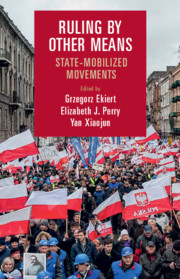Book contents
- Ruling by Other Means
- Cambridge Studies in Contentious Politics
- Ruling by Other Means
- Copyright page
- Contents
- Figures
- Tables
- Contributors
- Acknowledgments
- 1 State-Mobilized Movements: A Research Agenda
- 2 Manufactured Ambiguity
- 3 Suppressing Students in the People’s Republic of China
- 4 State-Mobilized Community Development
- 5 Enforcement Networks and Racial Contention in Civil Rights–Era Mississippi
- 6 Social Sources of Counterrevolution
- 7 Occupy Youth!
- 8 State-Mobilized Movements after Annexation of Crimea
- 9 Mirroring Opposition Threats
- 10 Mobilizing against Change
- 11 The Dynamics of State-Mobilized Movements
- 12 State-Mobilized Campaign and the Prodemocracy Movement in Hong Kong, 2013–2015
- 13 The Resurrection of Lei Feng
- Index
- Books in the Series (continued from p.iii)
- References
5 - Enforcement Networks and Racial Contention in Civil Rights–Era Mississippi
Published online by Cambridge University Press: 29 July 2020
- Ruling by Other Means
- Cambridge Studies in Contentious Politics
- Ruling by Other Means
- Copyright page
- Contents
- Figures
- Tables
- Contributors
- Acknowledgments
- 1 State-Mobilized Movements: A Research Agenda
- 2 Manufactured Ambiguity
- 3 Suppressing Students in the People’s Republic of China
- 4 State-Mobilized Community Development
- 5 Enforcement Networks and Racial Contention in Civil Rights–Era Mississippi
- 6 Social Sources of Counterrevolution
- 7 Occupy Youth!
- 8 State-Mobilized Movements after Annexation of Crimea
- 9 Mirroring Opposition Threats
- 10 Mobilizing against Change
- 11 The Dynamics of State-Mobilized Movements
- 12 State-Mobilized Campaign and the Prodemocracy Movement in Hong Kong, 2013–2015
- 13 The Resurrection of Lei Feng
- Index
- Books in the Series (continued from p.iii)
- References
Summary
Early in the fall of 1964, the governor of Mississippi, Paul B. Johnson, embarked on an unusual journey. His destination was the small railroad city of McComb, located halfway between Jackson, the state’s capitol, and New Orleans. Awaiting him at the end of the 80-mile drive were the area’s two top policing officials: McComb Police Chief George Guy and Pike County Sheriff R. W. Warren. The situation was urgent for all concerned, as McComb had become a steady presence in the national news for its charged racial situation – a series of vicious bombings had targeted supporters of a voter registration campaign mounted by a coalition of civil rights organizations. Local residents and national reporters alike were in on the open secret: the bombings had been perpetrated by members of local chapters of the Ku Klux Klan (KKK), a violent vigilante outfit that had mobilized extensively in McComb over the past year.
- Type
- Chapter
- Information
- Ruling by Other MeansState-Mobilized Movements, pp. 110 - 139Publisher: Cambridge University PressPrint publication year: 2020
References
- 1
- Cited by



